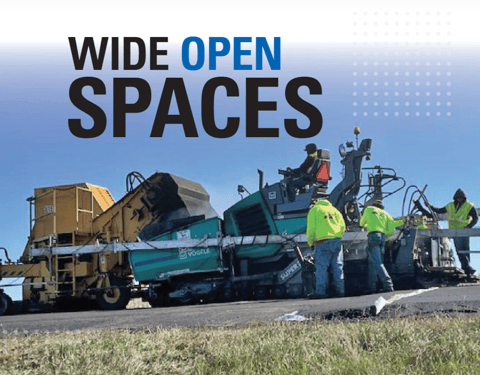(Indianapolis, IN) – Border States Paving is a family-owned general contractor that operates 2 permanent asphalt plants as well as a one portable plant which produce asphalt for the paving projects that they complete throughout the Dakotas, Wyoming and eastern Montana. In addition to the traditional paving tools that they use daily, BSP crews have adopted technology including FleetWatcher telematics to eliminate over trucking, streamline their operations, and eliminate the waste of traditional paper tickets with e-ticketing. Early in 2022 they integrated their FleetWatcher e-ticketing with OnStation to determine exact locations more precisely for each load of asphalt placed. On a paving
project along US Highway 12 in South Dakota this technology integration not only increased their accuracy, but it also made their jobsites safer.

The Project
BSP crews were tasked with paving US highway 12 eastward from Thunderhawk, South Dakota. Material was produced a portable plant located near Shadehill, South Dakota, approximately 20 miles away. The plant was running 450 tons of Q3R an hour from
sunup to sundown. There were 20 company owned trucks on the project, all equipped with FleetWatcher telematics hardwired into them, and an additional four 3rd party trucks equipped with FleetWatcher though portable devices. A total of 32,000 tons of asphalt was laid on the 13-mile project on both eastbound and westbound lanes of the 2-lane
highway. In addition to keeping the trucks staged to eliminate idling at the plant or paver, the telematics have helped in numerous ways, most notably through improved communications, according to BSP technology coordinator Lukas Slotten.
“If there were issues on the road or at the plant these guys are figuring out the problems and starting to fix them,” said Slotten. That has helped to eliminate over trucking, allowing them to get more production from fewer trucks, but has also improved the consistency of the asphalt being produced. “The plant man can see that they are coming up on a bridge so he can start slowing down the plant so that our hot sports aren’t as
severe. We can keep the drum turning and make our materials more consistent.” In addition to keeping the gradations more consistent on the materials, this eliminates any unnecessary wear and tear on the plant.
Manual Processes Present Opportunities
Previously on BSP projects, there would be a person collecting the tickets which contained the latitude and longitude of the dump location, and then estimating how far they were from the Station. “You’ve got your stations every 100 feet,” explains Slotten,
“and the ticket taker would estimate Station plus 50 feet. It was just a guess.” Slotten figured there had to be a better way.
“We started talking back and forth between BSP, FleetWatcher and OnStation, and the South Dakota DOT to see if we could use everyones technology and convert it into one,”
recalls Slotten. “We'll still have our checker on the side of the road writing down station numbers, but lets see how accurate they actually were.”
Turns out they were not very accurate.
“Before we were getting estimates - now we’re accurate to within a couple feet,” says Slotten.
This new functionality automatically tracks the load from the time it is loaded at the asphalt plant, through its dumping into the paver on the jobsite. The exact Station location becomes a part of the digital e-ticket, with no operator intervention required. Operators and transportation agency officials can know precisely on a jobsite where a specific load of asphalt was laid, so that if a future problem arises, they can investigate
other parameters around that location, including core tests, density, drainage, or others, to determine the scope of the problem.
How it Works
When a FleetWatcher equipped truck enters a jobsite geozone, the vehicles latitude/longitude is sent to OnStation. After verifying that it is part of the project, OnStation return the station, alignment, and offset where the load is deposited, which then becomes part of the e-ticket. The e-ticket then flows normally though to the DOT and BSP crew personnel. The process occurs automatically and replaces manual tracking and estimating by the BSP ticket taker, which was often erroneous.
Additionally, this Stationing information about each load is maintained in Fleetwatcher indefinitely for future use. Although there have not been any issues which required locating where a specific load of asphalt was placed on the Highway 12 project, Slotten knows that if one arises in the future, it can be easily and accurately found.
BSP still had a person to annotate each load as it was placed on the project, but that person was no longer beside the paver or walking up to trucks to collect paper tickets, then writing down station numbers and estimating locations. Now they are safely out of harm’s way.
“Now we’ve got a person off the road in a pickup. It’s just one less person out there to worry about when you’ve got big iron going down the road,’ says Slotten. “We were testing out the technology to see how well it works and how accurate it is. We found out
that its way more accurate than what we have been doing. And we’re hoping to eliminate
a person collecting the material because its already in FleetWatcher.”
It is also much more efficient for the project engineer to determine yields now, thanks to the seamless integration of FleetWatcher and OnStation. Now all of the information that he needs is already placed on the e-ticket, which he can access on his phone. There is no more collecting manual tickets then looking through them to figure yields, so the process
is simpler.
Another area where BSP is using technology to enhance their performance is with Intelligent Compaction or IC. A thermal camera on the back of the paver captures the temperature of the load and feeds this data to the inline rollers which are all equipped with IC, allowing them to achieve more uniform compaction. This was especially
important on the US Highway 12 project which was completed on October 22, as the South Dakota temperatures were in decline.
BSP certainly has all the traditional paving tools on hand to get the job done. But their use of technology allows them to do the job more accurately, efficiently, safely, and more consistently than ever before. Removing another person from the mix - by eliminating the ticket-taker function - will further enhance the efficiency and cost effectiveness of the technology.

